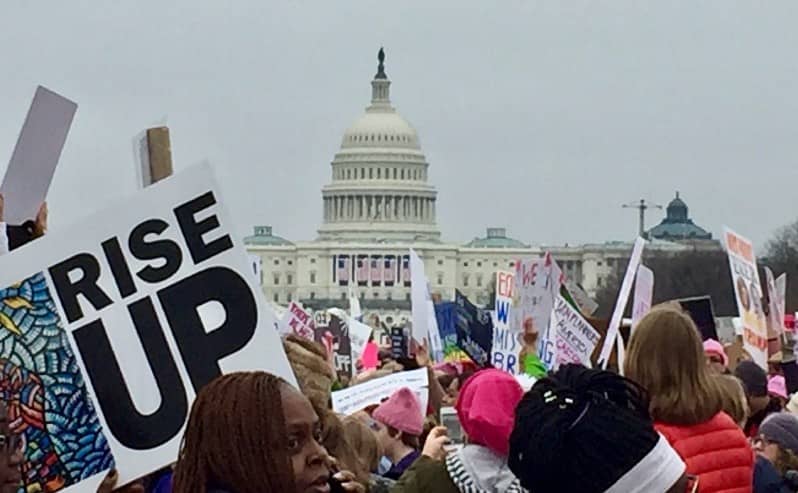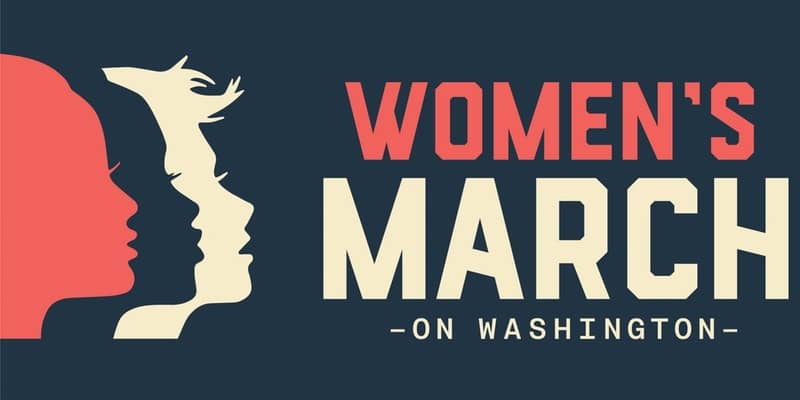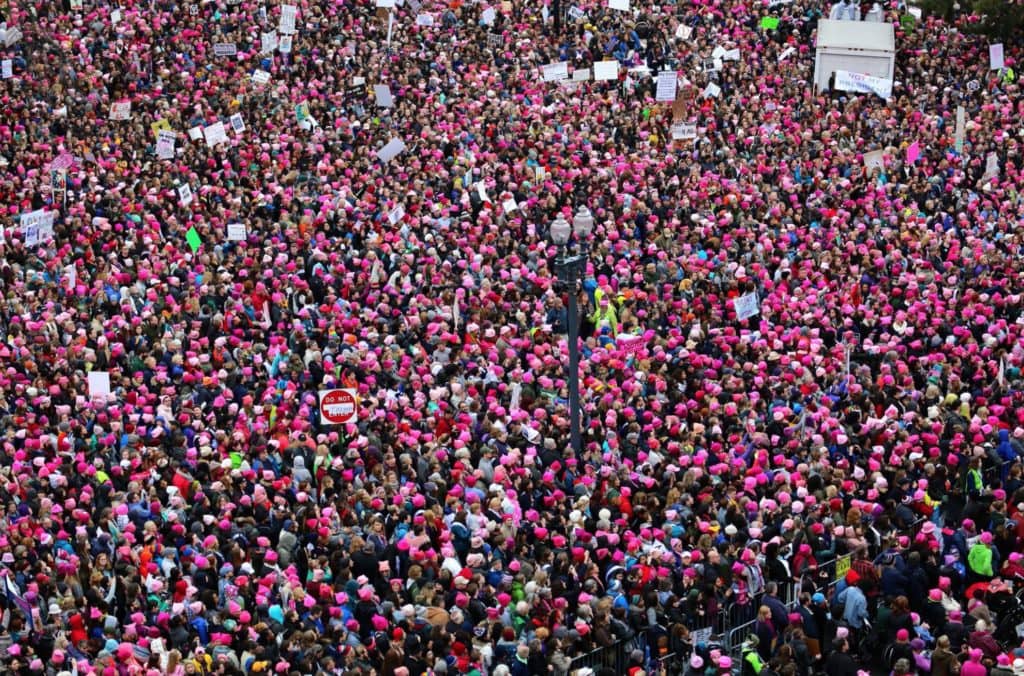
A Women’s March to Co-Create the Future for All Humanity
The energy of so many people careening toward Washington D.C. was palpable on January 21st.
I’d felt this power once before, 8 years ago as I arrived on the national mall with my family to wait in the freezing cold with 1.8 million others to witness the historic inauguration of Barack Obama. We felt deep pride and hopefulness that we had elected the first African American U.S. President. We were inspired by Obama’s intelligence, humility and frankly his humanity. Eight years later we were awed by the integrity of the man, even though we accepted that he was unable to achieve even a small measure of our aspirations from that frigid day of celebration in 2009.
The contrast between Obama and Trump coudn’t be more severe. My emotions were anger and despair when I travelled to Washington for the Women’s March (still working through the stages of grief).
Before I left for D.C. I pulled out my protest paraphernalia from as far back as 1980. Reagan’s election prompted my early activism. We launched a women’s network to protest the escalation of nuclear power and arms. Our founder, Dr. Helen Caldicott, had successfully rallied physicians to protest the nuclear threat, leveraging her credibility as a physician to make a scientific argument. Women flocked to her talks with deep concern; however, most lacked a basic understanding of international defense policy or political organizing. So we formed WAND to educate and organize women to advocate for people-centered policies. We tapped the power dynamics of the first presidential gender gap — a distinctly partisan voting pattern between women and men that still persists. As I prepared for this Women’s March 35 years later, I was uncomfortable with gender as an organizing frame. Are we women going to save democracy from this kleptocrat? After all, 42% voting women chose Trump compared to just 54% for Clinton. And white women skewed support for Trump.
I believe that today’s movement requires us to think and act beyond identity politics. We must create a swell of humanity who will override tribal fears and entrenched ‘isms’ to restore love, respect and democracy.

The origin story of the March is a reminder that even one grassroots activist can kindle massive resistance. As I understand it, Teresa Shook, a retired attorney and grandmother of 4 living in Hawaii, created a Facebook page suggesting a protest the night after the election. The next morning more than 10,000 people had responded. Simultaneously, Bob Bland from Brooklyn proposed a protest. She had several thousand Facebook followers from the ‘Nasty Woman’ t-shirts she produced to raise money for Planned Parenthood. They joined forces and The Women’s March was born. These two women were repulsed by Trump’s treatment of women and his disrespectful rhetoric. In shock from the election, their instinct was to protect their deepest concern — women’s rights. So they organized their women ‘friends’ to take to the streets to resist oppression.
There was plenty of in-fighting about race and gender, power and inclusion during preparations for the March as would be expected for a decentralized political movement. However, I did not experience any fracture at the March. Every aspect of the day celebrated inclusion and shared purpose. There was no police presence or violence. When a woman in a wheelchair needed to pass, the dense wall of marchers parted like the Red Sea. Children were offered perches for better visibility and men of all ages were embraced as valued allies. The theme that framed the gathering was intersectionality, a concept that originated with feminism. The March platform expressed these unity principles, “gender justice is racial justice is economic justice.” I have little doubt that people are organizing through a new prism that transcends identity politics in pursuit of the power we gain as a united front.
But the March was just a beginning warns Zeynep Tufekci, an academic who writes about technology, politics and society. Tufekci writes
“protests should be seen not as the culmination of an organizing effort, but as a first, potential step… The significance of a protest depends on what happens afterward.”

Trump awakened a sleeping giant, and I don’t mean the people who voted for him. Now what? The hard work has begun. The population at large rejects this administration’s tyranny. The question is, can we organize effectively and leverage our power to stop this insanity? Early indications are promising. Thousands of groups are springing up across the U.S. on a daily basis. More than one million people downloaded the Indivisible Guide produced by progressive congressional staffers to teach people how to influence Congress. RISE is another new citizen watchdog group gaining traction. And of course there are thousands of existing groups such as 350.org that already have engaged networks.
In my home of Providence, Rhode Island, the smallest and one of the bluest states, 1000 neighbours gathered the Saturday after the election to organize. Actions are continuing on a regular basis. Last Sunday, over 1000 people again rallied at our State House to decry the White House ban on people entering the U.S. from several Muslim countries. Even though we have a democratic congressional delegation, our Senators were flooded by rebukes when they approved Mike Pompeo’s appointment as Director of the CIA. After the immigration rally, protesters marched to a community dinner sponsored by Senator Whitehouse. Few could enter the crowded building so the Senator came outside to talk with the crowd. He later thanked those who had waited outside in the cold after the auditorium reached capacity. “I want you to know I heard all of your voices clearly, and I share your outrage about what we’ve seen from President Trump this week,” Whitehouse wrote. “There are going to be big fights ahead, and we’re going to have to keep speaking up and standing together. It has rarely mattered more.”
This is democracy in action.
Organizing takes place in groups big and small collaborating online and in person. They are place-based and issue focused and teeming with first time activists and old-timers alike. People are convening in person to share their fears and hopes, to strategize and to meditate. They’re also are capitalizing on technology to act fast to thwart threats. Digital organizing tools help mobilize distributed networks. Tufekci notes that we can learn from the Tea Party protests of 2009 that also mobilized thousands of protesters with the help of digital communications. Tea Party protesters pursued a ‘ferociously focused agenda’ according to Tufekci. They identified and supported “primary candidates to challenge Republicans who did not agree with their demands, keeping close tabs on legislation and pressuring politicians who deviated from a Tea Party platform.” We must be intersectional, focused, sophisticated and agile to combat this regime.
In a provocative article in The Atlantic, David Frum writes:
Those citizens who fantasize about defying tyranny from within fortified compounds have never understood how liberty is actually threatened in a modern bureaucratic state: not by diktat and violence, but by the slow, demoralizing process of corruption and deceit. And the way that liberty must be defended is not with amateur firearms, but with an unwearying insistence upon the honesty, integrity, and professionalism of American institutions and those who lead them. We are living through the most dangerous challenge to the free government of the United States that anyone alive has encountered. What happens next is up to you and me. Don’t be afraid. This moment of danger can also be your finest hour as a citizen and an American.
Let this be our finest hour as citizens of the world.
